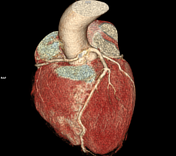Anomalous course of coronary arteries
Updates to Article Attributes
Anomalous course of a coronary artery is a type of congenital coronary artery anomaly. It may represent a benign and incidental finding, but rarely it is a malignant course predisposing patients to life-threatening myocardial ischaemia or arrhythmias, depending on where the artery runs.
Clinical presentation
The majority (approximately 80%) of anomalous coronary artery courses are benign and asymptomatic. However, on rare occasions, it may result in ischaemia, arrhythmias, or sudden death. Most symptomatic patients present at a young age.
Pathology
The coronary artery may pass between the aorta and the main pulmonary artery, representing a so-called interarterial course. It may be associated with a "slit-like" orifice in which an acute angle course at the ostium is more prone to occlusion. During physical activity, the artery may be compressed, and the flow within it may be compromised. The presence of a "slit-like" orifice or intramural course of the coronary artery within the aortic wall is more predictive of adverse outcome than the interarterial course alone.
There are four common courses for an anomalous coronary artery arising from the opposite sinus 4,5:
- malignant course
- interarterial (i.e. between the aorta and the pulmonary artery): this is the most dangerous as it carries a high risk of sudden cardiac death
- benign course
- retroaortic coronary course
- prepulmonic coronary course
- septal (subpulmonic)
Treatment and prognosis
The treatment of anomalous coronary arteries is controversial. Patients with a benign course rarely need surgical treatment. Symptomatic patients with an interarterial course may require surgical "re-implantation" of the anomalous coronary artery or "de-roofing" if an intramural course is present.
-<p><strong>Anomalous course of a coronary artery</strong> is a type of <a href="/articles/congenital-coronary-artery-anomalies">congenital coronary artery anomaly</a>. It may represent a benign and incidental finding, but rarely it is a malignant course predisposing patients to life-threatening <a href="/articles/myocardial-ischaemia">myocardial ischaemia</a> or <a href="/articles/arrhythmia">arrhythmias</a>, depending on where the artery runs. </p><h4>Clinical presentation</h4><p>The majority (approximately 80%) of anomalous coronary artery courses are benign and asymptomatic. However, on rare occasions, it may result in ischaemia, arrhythmias, or sudden death. Most symptomatic patients present at a young age.</p><h4>Pathology</h4><p>The coronary artery may pass between the <a href="/articles/aorta">aorta</a> and the <a href="/articles/pulmonary-trunk">main pulmonary artery</a>, representing a so-called interarterial course. It may be associated with a "slit-like" orifice in which an acute angle course at the ostium is more prone to occlusion. During physical activity, the artery may be compressed, and the flow within it may be compromised. The presence of a "slit-like" orifice or intramural course of the coronary artery within the aortic wall is more predictive of adverse outcome than the interarterial course alone.</p><p>There are four common courses for an anomalous coronary artery arising from the opposite sinus <sup>4,5</sup>:</p><ul>-<li>malignant course<ul><li>interarterial (i.e. between the aorta and the pulmonary artery): this is the most dangerous as it carries a high risk of sudden cardiac death </li></ul>-</li>-<li>benign course<ul>-<li><a href="/articles/retroaortic-coronary-course">retroaortic coronary course</a></li>-<li><a href="/articles/prepulmonic-coronary-course">prepulmonic coronary course</a></li>-<li>septal (subpulmonic)</li>-</ul>-</li>- +<p><strong>Anomalous course of a coronary artery</strong> is a type of <a href="/articles/congenital-coronary-artery-anomalies">congenital coronary artery anomaly</a>. It may represent a benign and incidental finding, but rarely it is a malignant course predisposing patients to life-threatening <a href="/articles/myocardial-ischaemia">myocardial ischaemia</a> or <a href="/articles/arrhythmia">arrhythmias</a>, depending on where the artery runs. </p><h4>Clinical presentation</h4><p>The majority (approximately 80%) of anomalous coronary artery courses are benign and asymptomatic. However, on rare occasions, it may result in ischaemia, arrhythmias, or sudden death. Most symptomatic patients present at a young age.</p><h4>Pathology</h4><p>The coronary artery may pass between the <a href="/articles/aorta">aorta</a> and the <a href="/articles/pulmonary-trunk">main pulmonary artery</a>, representing a so-called interarterial course. It may be associated with a "slit-like" orifice in which an acute angle course at the ostium is more prone to occlusion. During physical activity, the artery may be compressed, and the flow within it may be compromised. The presence of a "slit-like" orifice or intramural course of the coronary artery within the aortic wall is more predictive of adverse outcome than the interarterial course alone.</p><p>There are four common courses for an anomalous coronary artery arising from the opposite sinus <sup>4,5</sup>:</p><ul>
- +<li>malignant course<ul><li>interarterial (i.e. between the aorta and the pulmonary artery): this is the most dangerous as it carries a high risk of sudden cardiac death </li></ul>
- +</li>
- +<li>benign course<ul>
- +<li><a href="/articles/retroaortic-coronary-course">retroaortic coronary course</a></li>
- +<li><a href="/articles/prepulmonic-coronary-course">prepulmonic coronary course</a></li>
- +<li>septal (subpulmonic)</li>
- +</ul>
- +</li>
Image 14 CT (VR) ( create )








 Unable to process the form. Check for errors and try again.
Unable to process the form. Check for errors and try again.